Computation of Gamma Buildup Factors and Heavy Ions Penetrating Depths in Clay Composite Materials Using Phy-X/PSD, EXABCal and SRIM Codes
Abstract
1. Introduction
2. Materials and Methods
3. Results and Discussions
3.1. Variation of EBF and EABF with Incident Gamma Energy
3.2. SRIM Simulation Results
4. Conclusions
Author Contributions
Funding
Institutional Review Board Statement
Informed Consent Statement
Data Availability Statement
Acknowledgments
Conflicts of Interest
References
- Olukotun, S.; Gbenu, S.; Ibitoye, F.; Oladejo, O.; Shittu, H.; Fasasi, M.; Balogun, F. Investigation of gamma radiation shielding capability of two clay materials. Nucl. Eng. Technol. 2018, 50, 957–962. [Google Scholar] [CrossRef]
- Tajudin, S.; Sabri, A.; Aziz, M.A.; Olukotun, S.; Ojo, B.; Fasasi, M. Feasibility of clay-shielding material for low-energy photons (Gamma/X). Nucl. Eng. Technol. 2019, 51, 1633–1637. [Google Scholar] [CrossRef]
- Fugaru, V.; Bercea, S.; Postolache, C.; Manea, S.; Moanta, A.; Petre, I.; Gheorghe, M. Gamma ray shielding properties of some concrete materials. Acta Phys. Pol. A 2015, 127, 1427–1429. [Google Scholar] [CrossRef]
- Sayyed, M.; Lakshminarayana, G.; Kityk, I.; Mahdi, M. Evaluation of shielding parameters for heavy metal fluoride based tellurite-rich glasses for gamma ray shielding applications. Radiat. Phys. Chem. 2017, 139, 33–39. [Google Scholar] [CrossRef]
- Sayyed, M.; Elhouichet, H. Variation of energy absorption and exposure buildup factors with incident photon energy and penetration depth for boro-tellurite (B2O3-TeO2) glasses. Radiat. Phys. Chem. 2017, 130, 335–342. [Google Scholar] [CrossRef]
- Sayyed, M.; Alzaatreh, M.; Dong, M.; Zaid, M.; Matori, K.; Tekin, H.O. A comprehensive study of the energy absorption and exposure buildup factors of different bricks for gamma-rays shielding. Results Phys. 2017, 7, 2528–2533. [Google Scholar] [CrossRef]
- Kavaz, E.; Tekin, H.; Agar, O.; Altunsoy, E.; Kilicoglu, O.; Kamislioglu, M.; Abuzaid, M.; Sayyed, M. The Mass stopping power/projected range and nuclear shielding behaviors of barium bismuth borate glasses and influence of cerium oxide. Ceram. Int. 2019, 45, 15348–15357. [Google Scholar] [CrossRef]
- Olarinoye, I. Variation of effective atomic numbers of some thermoluminescence and phantom materials with photon energies. Res. J. Chem. Sci. 2011, 1, 64–69. [Google Scholar]
- Olukotun, S.; Gbenu, S.; Oladejo, O.; Sayyed, M.; Tajudin, S.; Amosun, A.; Fadodun, O.; Fasasi, M. Investigation of gamma ray shielding capability of fabricated clay-polyethylene composites using EGS5, XCOM and Phy-X/PSD. Radiat. Phys. Chem. 2020, 177, 109079. [Google Scholar] [CrossRef]
- Olukotun, S.; Gbenu, S.; Oladejo, O.; Balogun, F.; Sayyed, M.; Tajudin, S.; Obiajunwa, E.; Fasasi, M. The effect of incorporated recycled low density polyethylene (LDPE) on the fast neutron shielding behaviour (FNSB) of clay matrix using MCNP and PHITS Monte Carlo codes. Radiat. Phys. Chem. 2021, 182, 109351. [Google Scholar] [CrossRef]
- Olukotun, S.F.; Gbenu, S.T.; Oyedotun, K.O.; Fasakin, O.; Sayyed, M.I.; Akindoyin, G.O.; Shittu, H.O.; Fasasi, M.K.; Khandaker, M.U.; Osman, H.; et al. Fabrication and characterization of clay-polyethylene composite opted for shielding of ionizing radiation. Crystals 2021, 11, 1068. [Google Scholar] [CrossRef]
- Olarinoye, I.; Odiaga, R.; Paul, S. EXABCal: A program for calculating photon exposure and energy absorption buildup factors. Heliyon 2019, 5, e02017. [Google Scholar] [CrossRef] [PubMed]
- Şakar, E.; Özpolat, Ö.F.; Alım, B.; Sayyed, M.; Kurudirek, M. Phy-X/PSD: Development of a user friendly online software for calculation of parameters relevant to radiation shielding and dosimetry. Radiat. Phys. Chem. 2020, 166, 108496. [Google Scholar] [CrossRef]
- Harima, Y. An approximation of gamma-ray buildup factors by modified geometrical progression. Nucl. Sci. Eng. 1983, 83, 299–309. [Google Scholar] [CrossRef]
- Allard, T.; Calas, G. Radiation effects on clay mineral properties. Appl. Clay Sci. 2009, 43, 143–149. [Google Scholar] [CrossRef]
- Ziegler, J.F.; Ziegler, M.D.; Biersack, J.P. SRIM—The stopping and range of ions in matter. Nucl. Instrum. Methods B 2010, 268, 1818–1823. [Google Scholar] [CrossRef]
- ANSI/ANS-6.4.3; Gamma Ray Attenuation Coefficient and Buildup Factors for Engineering Materials. American Nuclear Society: La Grange Park, IL, USA, 1991.
- Singh, V.; Badiger, N. Gamma-ray exposure build-up factors of some brick materials in the state of Punjab. Radioprotection 2013, 48, 511–526. [Google Scholar] [CrossRef]
- Singh, V.P.; Badiger, N. Energy absorption buildup factors, exposure buildup factors and Kerma for optically stimulated luminescence materials and their tissue equivalence for radiation dosimetry. Radiat. Phys. Chem. 2014, 104, 61–67. [Google Scholar] [CrossRef]
- Bursalıoğlu, E.; Balkan, B.; Kavanoz, H.B.; Okutan, M.; Íçelli, O.; Yalçın, Z. Energy absorption and exposure buildup factors of essential amino acids. BioMed Res. Int. 2014, 2014, 359754. [Google Scholar] [CrossRef]
- Sayyed, M. Half value layer, mean free path and exposure buildup factor for tellurite glasses with different oxide compositions. J. Alloy. Compd. 2017, 695, 3191–3197. [Google Scholar] [CrossRef]
- Obaid, S.S.; Sayyed, M.; Gaikwad, D.; Pawar, P. Attenuation coefficients and exposure buildup factor of some rocks for gamma ray shielding applications. Radiat. Phys. Chem. 2018, 148, 86–94. [Google Scholar] [CrossRef]
- Hlatshwayo, T.; Sebitla, L.; Njoroge, E.; Mlambo, M.; Malherbe, J. Annealing effects on the migration of ion-implanted cadmium in glassy carbon. Nucl. Instrum. Methods Phys. Res. Sect. B Beam Interact. Mater. Atoms 2017, 395, 34–38. [Google Scholar] [CrossRef][Green Version]
- Dran, J. Radiation effects in radioactive waste storage materials. Solid State Phenom. 1992, 30–31, 367–378. [Google Scholar] [CrossRef]
- Sorieul, S.; Allard, T.; Wang, L.M.; Grambin-Lapeyre, C.; Lian, J.; Calas, G.; Ewing, R.C. Radiation-stability of smectite. Environ. Sci. Technol. 2008, 42, 8407–8411. [Google Scholar] [CrossRef] [PubMed]

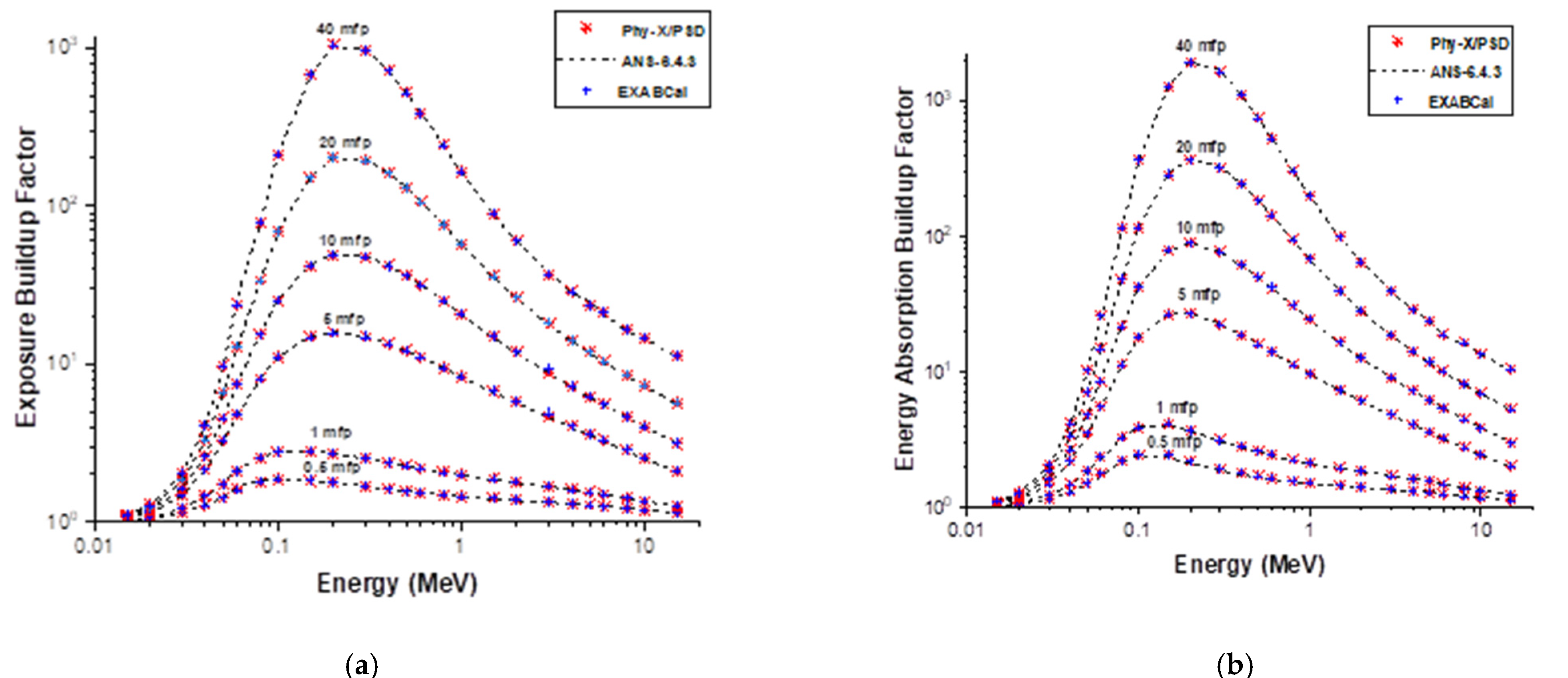
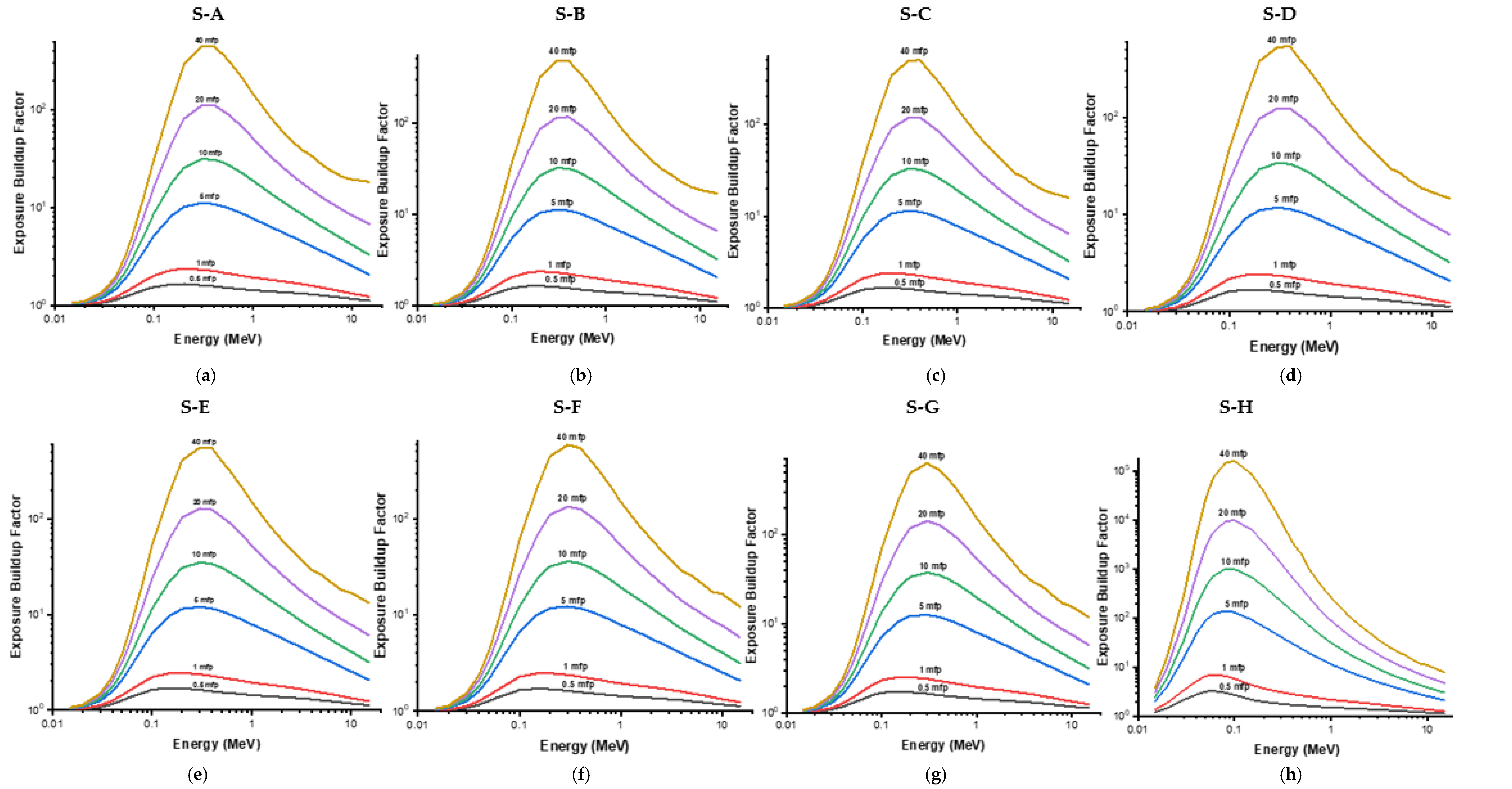


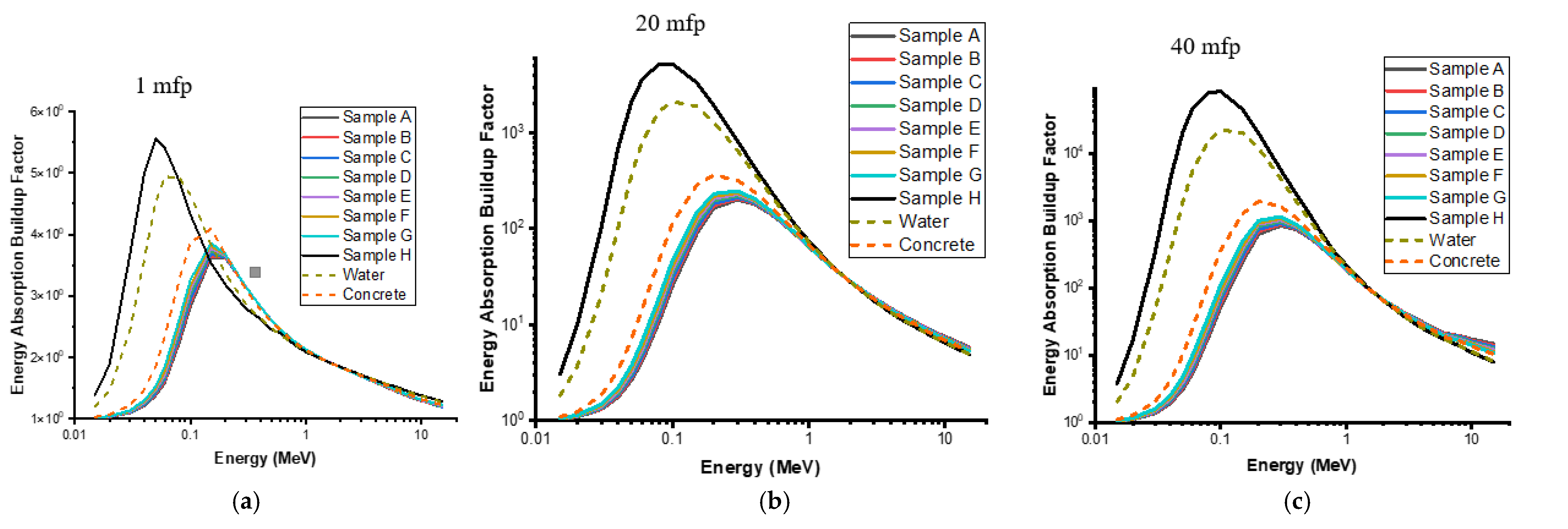


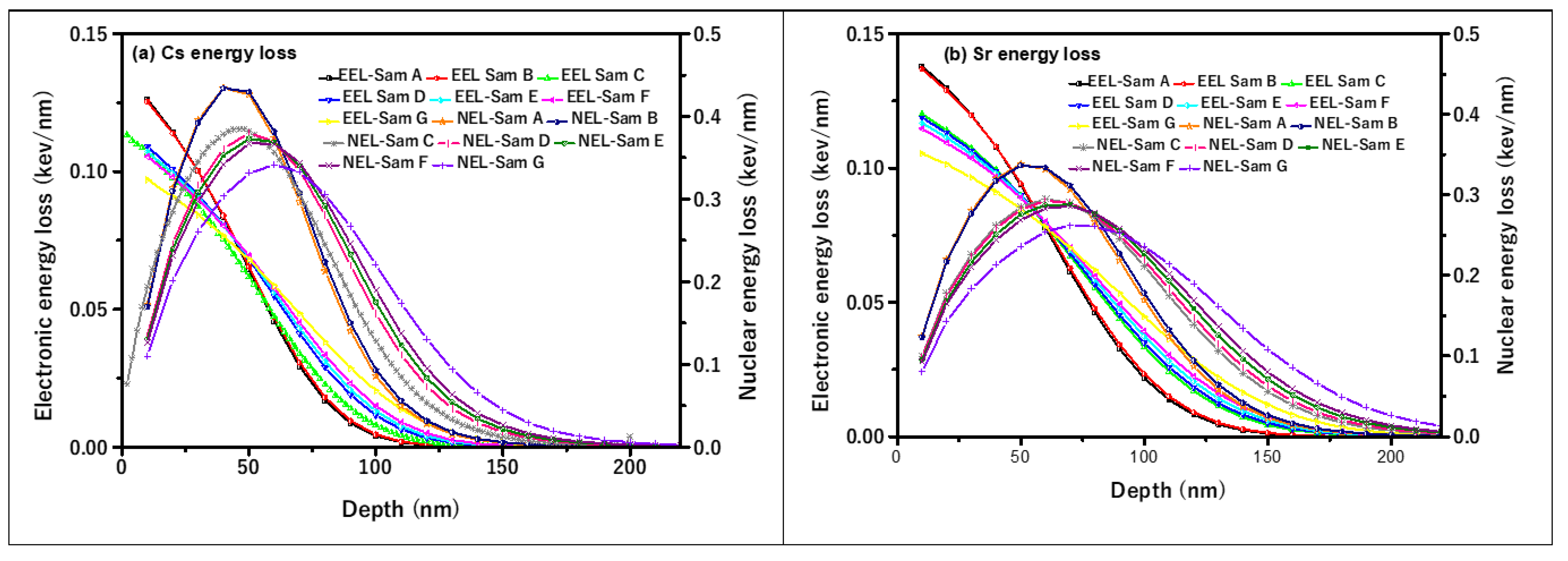
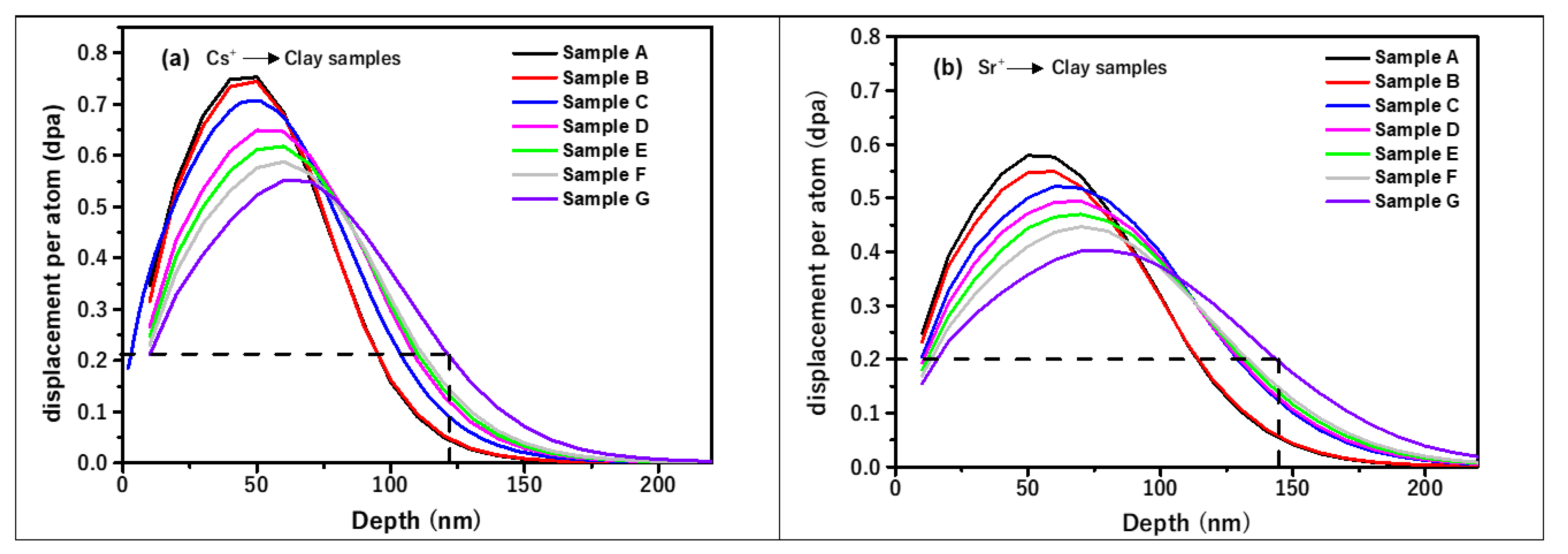
| Ion | Sample | Density (g·cm−3) | Projected Range (nm) | Projected Range Straggling (nm) | Skewness (γ) | Kurtosis (β) |
|---|---|---|---|---|---|---|
| S-A | 2.030 | 66.5 | 21.0 | 0.40 | 3.06 | |
| S-B | 1.975 | 67.9 | 21.2 | 0.40 | 3.08 | |
| S-C | 1.688 | 78.8 | 24.5 | 0.38 | 3.00 | |
| Sr | S-D | 1.633 | 81.1 | 25.0 | 0.40 | 3.00 |
| S-E | 1.567 | 83.9 | 25.6 | 0.30 | 3.00 | |
| S-F | 1.501 | 87.2 | 26.2 | 0.35 | 3.00 | |
| S-G | 1.341 | 96.6 | 28.8 | 0.34 | 2.99 | |
| S-A | 2.030 | 80.8 | 29.4 | 0.37 | 2.97 | |
| S-B | 1.975 | 82.5 | 29.9 | 0.37 | 2.99 | |
| S-C | 1.688 | 96.0 | 34.4 | 0.35 | 2.95 | |
| Cs | S-D | 1.633 | 98.4 | 35.0 | 0.34 | 2.95 |
| S-E | 1.567 | 101.9 | 35.9 | 0.33 | 2.92 | |
| S-F | 1.501 | 105.5 | 36.8 | 0.32 | 2.93 | |
| S-G | 1.341 | 117.2 | 40.5 | 0.31 | 2.92 |
Publisher’s Note: MDPI stays neutral with regard to jurisdictional claims in published maps and institutional affiliations. |
© 2022 by the authors. Licensee MDPI, Basel, Switzerland. This article is an open access article distributed under the terms and conditions of the Creative Commons Attribution (CC BY) license (https://creativecommons.org/licenses/by/4.0/).
Share and Cite
Olukotun, S.F.; Sayyed, M.I.; Oladejo, O.F.; Almousa, N.; Adeojo, S.A.; Ajoge, E.O.; Gbenu, S.T.; Fasasi, M.K. Computation of Gamma Buildup Factors and Heavy Ions Penetrating Depths in Clay Composite Materials Using Phy-X/PSD, EXABCal and SRIM Codes. Coatings 2022, 12, 1512. https://doi.org/10.3390/coatings12101512
Olukotun SF, Sayyed MI, Oladejo OF, Almousa N, Adeojo SA, Ajoge EO, Gbenu ST, Fasasi MK. Computation of Gamma Buildup Factors and Heavy Ions Penetrating Depths in Clay Composite Materials Using Phy-X/PSD, EXABCal and SRIM Codes. Coatings. 2022; 12(10):1512. https://doi.org/10.3390/coatings12101512
Chicago/Turabian StyleOlukotun, S. F., M. I. Sayyed, O. F. Oladejo, Nouf Almousa, S. A. Adeojo, E. O. Ajoge, S. T. Gbenu, and M. K. Fasasi. 2022. "Computation of Gamma Buildup Factors and Heavy Ions Penetrating Depths in Clay Composite Materials Using Phy-X/PSD, EXABCal and SRIM Codes" Coatings 12, no. 10: 1512. https://doi.org/10.3390/coatings12101512
APA StyleOlukotun, S. F., Sayyed, M. I., Oladejo, O. F., Almousa, N., Adeojo, S. A., Ajoge, E. O., Gbenu, S. T., & Fasasi, M. K. (2022). Computation of Gamma Buildup Factors and Heavy Ions Penetrating Depths in Clay Composite Materials Using Phy-X/PSD, EXABCal and SRIM Codes. Coatings, 12(10), 1512. https://doi.org/10.3390/coatings12101512








